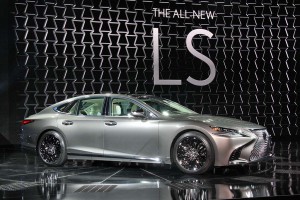Two months after unveiling its all-new LS flagship sedan, Lexus is back at it, rolling out the plug-in hybrid version at the 2017 Geneva Motor Show.
Where the next-generation LS 500 – which debuted at the Detroit Auto Show – opted for a twin-turbo V-6, the Lexus LS 500h will be motivated by a complex new driveline that not only combines gas and electric power sources but also two separate gearboxes.
The one thing that doesn’t change is the basic exterior design, which adopts the more aggressive look called for by parent Toyota Motor Corp. CEO Akio Toyoda who, in a visit to the 2015 Detroit Auto Show, declared Lexus would put more “passion” into both its design and driving dynamics. With its yawning spindle grille and creased sheet metal, both versions of the new LS offer a more exciting and distinctive design than the staid, classic Lexus cruisers of the past.
“Developing such a flagship model required a massive paradigm shift,” said Chief Engineer Toshio Asahi. Rather than being bound by the conventions that had defined luxury cars in the past, we aimed to create a car with innovative, emotional and sensual appeal that would draw customers’ eyes away from other luxury cars and provide entirely new values.”
(Lexus to reveal new LS 500h hybrid in Geneva. Click Here for the story.)
Inside, the Lexus LS 600h is intended to speak luxury, but with a readily apparent touch of traditional Japanese craftsmanship. That includes the distinctive graining of veneers that combine multiple woods, as well as hand-pleated door trims that create a 3D, origami effect. There are also hand-blown pieces of glass accents created by Kiriko artisans.
Lexus was the first luxury brand to go with a conventional hybrid, and the previous model’s highest-priced package was its battery-electric variant. Lexus isn’t talking price yet, but it is likely to follow the same approach this time, observers believe, considering the complexity of the new Lexus Multi Stage Hybrid System, as well as all the features the LS 500h comes with as standard gear.
The drivetrain is one of the first that Toyota has offered migrating from older-style nickel-metal hydride to lithium-ion batteries. That results in a 20% smaller package, one that is also lighter and more powerful – something that translates into better performance and mileage.
Virtually the same as the Multi Stage system also offered in the Lexus LC 400h coupe, the hybrid LS pairs a 3.5-liter V6 Dual VVT-i V6 gasoline engine and two electric motors, delivering a combined maximum system power of 354 horsepower. That’s enough to launch the big LS 500h from 0 to 60 in a mere 5.4 seconds.
(Click Here to see more about TDB’s first drive in the Lexus RC 350 F Sport.)
(By comparison, the twin-turbo LS 500 makes 415 hp and hits 60 in 4.5 seconds in rear-wheel-drive configuration, 4.8 seconds with all-wheel-drive.)
To further improve fuel economy, the internal combustion side of the system adopts narrow, lightweight roller rocker arms, low-friction timing chains and a unique fuel injection system.
One of the more unusual engineering solutions sees the engine pair the familiar Lexus continuously variable transmission with a four-speed automatic gearbox. The strategy creates the equivalent of a 10-speed transmission. The idea was to “amplify” power under hard acceleration, according to Lexus engineers. It also helps avoid the dreaded “rubber band effect” that is a frequent complaint among owners of hybrids and other vehicles using CVTs.
As for fuel economy, expect a noticeable bump up from the outgoing LS hybrids 19 mpg City, 23 Highway and 20 Combined. Final numbers await formal EPA testing.
(Lexus aims to set new benchmark with 5th-gen LS. Click Here for the story.)
Separately, Lexus will announce pricing closer to its on-sale date later this year.


